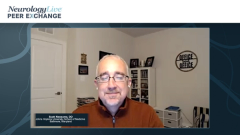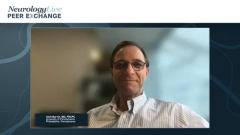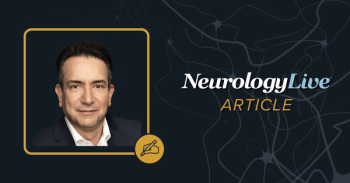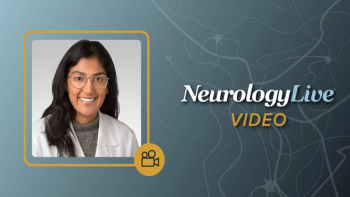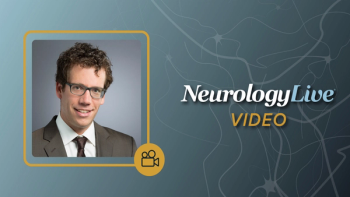
Clinical Trial Design Considerations for MS
Experts in neurology comment on clinical trial design considerations and discuss novel imaging techniques and biomarkers that they consider most important to investigate for multiple sclerosis.
Episodes in this series

Scott Newsome, DO: One thing I was thinking about is the severity of illness. If someone has full-blown mono when they’re a teenager and it’s quite severe, and they develop MS [multiple sclerosis] vs someone who’s asymptomatic. Is that going to tell us anything down the road regarding the severity of the illness or the change to progression? One thing I find very difficult is that when I do some clinical trial work, it’s always about finding the right outcome measures. For a study where you’re looking at a vaccine—and this is for all of you, whoever wants to jump in—what end points would we want to look at? We use these 2-year phase 3 trials, and we see a modest impact on progression. But if you really want to look at progression, you want to look at 5, 10, 15 years out, but we don’t want to wait that long. I wonder if there are any novel imaging techniques or novel biomarkers. Amit earlier mentioned NFL. What are your thoughts? Anyone can jump in.
Amit Bar-Or, MD, FRCPC: I can take an initial stab. I’d divide it into 2 parts. One is that depending on whether you’re doing a study that’s trying to prevent or limit new relapsing disease activity or limit nonrelapsing progressive disease, you’ll certainly try to incorporate all the things you’ve used in other traditional clinical trials that assess the same. Getting ancillary biological substudies in this context is going to teach us a lot.
One steppingstone, for example, is if you think of the many patients on anti-CD20, some of whom are going to end up stopping for a variety of reasons. Some people get new disease activity. If EBV [Epstein-Barr virus] is driving all MS attacks, maybe there’s something to be measured biologically in those who develop new disease activity vs those who don’t develop new disease activity. Will that teach us something important, including maybe increasing our rationale and motivation to do a bigger study on relapsing/remitting MS to limit relapses?
The second piece: is there anything unique to EBV that we’d consider measuring differently by virtue of it being EBV or how it may be involved in the disease? In the context of the progressive disease, the hypothesis from an EBV perspective would be that EBV resides in the CNS [central nervous system] and is either itself or through immune responses to it…contributing to injury. Can we imagine that in ways? Our initial excitement about looking at meningeal gadolinium signals was somewhat diminished when we realized that it’s probably not sensitive to all the follicle-related areas. In fact, it’s very clearly macro visible, whereas the follicle-like structures are minuscule and microscopic. It’s not 1:1.
Danny Reich would, I think, be the first to submit that what he initially described with Martina Absinta is likely to be a larger structure. There may be some changes within the meninges that trap gadolinium. They’re not necessarily a focus of inflammatory cells or inflammation, although they may be somehow related to it. With the approaches of assessing chronic active lesions, like the slowly evolving and slowly expanding lesions or pearls, or the paramagnetic rim lesions, we’re excited about—in the context of progressive trials—the prospect of picking up some manifestation contributing to progressive disease. Whether those have to do with EBV is another question. They may be part of progressive disease, but it’s not clear that they’re going to be harboring cells that are EBV infected to the same extent as the meningeal cells. Those have been described as harboring in the context of the subpial cortical injury. More recently, and soon to be published, with thalamic period ventricular regions as well.
Ahmed Obeidat, MD, PhD: I’d like to talk about our clinical outcomes. For those trials, if we look at some ability improvements, this is 1 of the things we should look at. We always think about worsening, but maybe we can look at something like this as a novel outcome and see if there’s a subgroup of patients who show some improvement—maybe in mobility, maybe in cognitive function, maybe in some of the other abilities that people with MS have.
One other thing is focusing on technology integration into some of these clinical outcomes. We all know the EDSS [Expanded Disability Status Scale] and its limitations. It’s a great test. It’s a great scale. But it has some limitations. Integrating technology and more precision measurements may help us in future clinical trials as we think about designing more sensitive outcome measures for ability in multiple sclerosis. That’s what I’d think about adding for clinical measures in trials in MS.
Scott Newsome, DO: What do you think, Bridget? Ahmed mentioned improvement in functionality, which is very challenging based on what we learned from the ozanimod trial RADIANCE and the failures there.
Bridget A. Bagert, MD: That’s what a cure is. That’s what we should aim for. That’s what patients will tell you a cure looks like to them. It’s an improvement in their function. I was having another thought for a novel outcome specific to EBV, and they’re doing this in the Atara Biotherapeutics trial of T cells. In the phase 2 trial…looking at the number of oligoclonal bands or the IgG index, both measuring individual differences over time to see if that number goes down, which is an interesting question. It’s very much exploratory, but it’s based on the purported theory, the biology. The hypothesis is that if the donor T cells are making a difference in eradicating some of this entrenched B-cell inflammation in the brain, the number of oligoclonal bands will go down over time in these progressive patients. That’s interesting.
Scott Newsome, DO: This will be interesting. I remember being in medical school and beyond. Once oligoclonal bands are present, they’re always present. Depending on what assay you’re looking at, you can count or not. Where I am, they just give you pattern 2, which is more than 2 oligoclonal bands that are present within the CSF [cerebrospinal fluid] that are unique.
Transcript Edited for Clarity
Newsletter
Keep your finger on the pulse of neurology—subscribe to NeurologyLive for expert interviews, new data, and breakthrough treatment updates.

